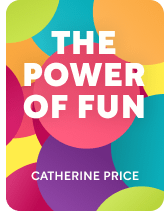

This article is an excerpt from the Shortform book guide to "The Power of Fun" by Catherine Price. Shortform has the world's best summaries and analyses of books you should be reading.
Like this article? Sign up for a free trial here.
When was the last time you did something fun? What if fun didn’t have to take a backseat to your neverending list of adult responsibilities?
For many of us, the older we get, the less we prioritize having fun. Catherine Price uses research and personal anecdotes to explain why fun is fundamental to living a happy and healthy life and how everyone can start having more fun.
Continue reading for an overview of The Power of Fun: How to Feel Alive Again.
Overview of The Power of Fun: How to Feel Alive Again
Price is an award-winning science writer, speaker, and consultant. She’s the author of several books including Vitamania and How to Break Up With Your Phone. She’s also the founder of ScreenLifeBalance.com, a resource hub dedicated to helping people create more intentional relationships with technology and reconnect with what really matters to them. Her journalistic work has appeared in publications including The Best American Science Writing, The New York Times, and O: The Oprah Magazine.
In our overview of The Power of Fun: How to Feel Alive Again, we’ll start by defining fun and why it matters before explaining how modern society has made it harder to prioritize fun. We’ll then outline Price’s step-by-step guide to inviting more fun into your life.
What Is True Fun, & Why Does It Matter?
According to Price, the word fun has been used to describe so many different types of experiences that it has begun to lose some of its meaning. We use fun to describe anything from getting a massage to going skydiving. She explains that many of us also mistake activities like binge-watching a show or scrolling on social media for fun when these activities are a little more than a distraction or passive entertainment that rarely leaves us feeling better than before.
Price focuses on what she calls True Fun, the kind of fun that leaves you feeling energized and inspired. She argues that True Fun isn’t only the most enjoyable kind of fun, but it’s also good for your physical and emotional well-being. Price defines True Fun as the intersection of playfulness, connection, and flow. We’ll discuss each component in turn.
Playfulness
Price defines playfulness as a liberating attitude of curiosity, openness, and willingness to experiment. Playfulness is about doing something just for the sake of doing it, not because it is “productive” or has a higher purpose. Playfulness is less about any specific activity than the attitude you bring to what you’re doing.
Citing the work of Stuart Brown, psychiatrist and founder of the National Institute for Play, Price explains that engaging in play can allow people to get back in touch with their most authentic selves. Studies have also shown that play enhances creativity, improves memory, and decreases stress, in addition to facilitating deeper relationships with other people.
Connection
Price defines connection as a sense of belonging and intimacy that arises from feeling understood and valued. Price explains that this connection can take many forms, from deep conversations with friends to spending time in nature or playing with a beloved pet. While we can be connected to places and things, Price notes that most instances of True Fun involve connecting with other people.
Research suggests that human connection is central to our physical and emotional well-being. While loneliness has been linked to a variety of health issues (for example, high blood pressure, heart disease, depression, and dementia), studies have shown that strong social relationships are a better indicator of long-term health outcomes than almost any other indicator, including income, IQ, social class, or genetics.
Flow
The third component of True Fun is flow. Price defines flow as a state of complete absorption in an activity, where a person is fully immersed in the present moment and loses track of time. She explains that flow is characterized by effortless concentration and a feeling of being in control, despite the challenge of the activity. Flow can be experienced in a variety of activities: playing music, engaging in a sport or physical activity, or even in everyday tasks like cooking or gardening.
Price argues that opportunities for flow are crucial for a long and fulfilling life. She equates flow with the Japanese concept of ikigai, which roughly translates to “a reason for being.” Price points to the research of Héctor García and Francesc Miralles, authors of Ikigai, who studied the residents of the Japanese island of Okinawa. The authors contend that Okinawa residents live especially long lives because they practice ikigai every day by engaging in meaningful and joyful activities—in other words, by engaging in flow.
According to Price, the convergence of the three variables of playfulness, connection, and flow often leads to experiences of True Fun, which will vary from person to person. For example, for different people, playing rugby, birdwatching, or online poker might each meet the requirements for True Fun. Price concludes that, if each of these three separate components of True Fun has so many benefits, then the combination of all three must be even more potent.
Why Are We Having Less Fun?
Price argues that despite research that seems to demonstrate the positive impact fun has on our lives, people today spend less time having fun than previous generations. She explains that our changing relationships to time and technology inhibit our opportunities for play, connection, and flow that are necessary to experience True Fun.
Our Changing Relationship to Time
Citing the work of Celeste Headlee, author of Do Nothing, Price explains how the rise of industrialization meant workers began being paid by the hour instead of for completed tasks, establishing an incentive to work as many hours as possible to make as much money as possible. Suddenly, time was equivalent to money, leading to the assumption that time not spent making money (including time spent having fun) is time wasted.
The changing attitude toward time was coupled with the rise of consumer culture. The Industrial Revolution resulted in an increase in the mass production of goods, which companies then needed to sell to make a profit. To sell the oversupply of goods, companies needed to create demand, which they did by building marketing campaigns that convinced people that owning more stuff would make their lives better.
The result was that people spent more time working in order to be able to buy more things that were marketed as a means to improve life, leaving them less time to pursue opportunities for playfulness, connection, and flow.
Our Changing Relationship to Technology
Our increasing dependence on technology, and specifically smartphones, has further weakened the role of fun in our lives, primarily by replacing True Fun with lesser forms of fun, like distraction and passive entertainment. Price argues that smartphones are the number one source of this kind of bogus fun because they’re designed to be addictive, relying on novelty, rewards, and a lack of predictability to hold our attention. While Price acknowledges that our phones can provide a temporary escape from stress or boredom, she argues that they ultimately fail to contribute to our overall happiness and well-being.
According to Price, the ubiquity of smartphones also limits our capacity for playfulness, connection, and flow. Phones contribute to our sense of busyness and stress, which makes it difficult to relax and engage in spontaneous, unstructured play. Our overreliance on technology for entertainment has also limited our ability to be imaginative and creative. In addition, phones, despite the illusion of connectedness they provide, isolate us by making us less likely to initiate conversations with strangers or put effort into quality in-person interactions. Worst of all, phones are a constant source of distraction, which prevents us from ever entering a flow state.
How Can You Have More Fun?
Having explained the power of True Fun and why it has become harder to find it, we’ll now give Price’s tips to start incorporating more fun into your life.
Start With a Self-Assessment
Before making any major changes, Price suggests taking time to do a self-assessment (or “fun audit”) of your current relationship to fun to better understand what True Fun means for you.
Step 1: Identify what fun feels like. Many of us are acutely aware of what stress and worry feel like. We spend less time thinking about what fun feels like. Ask yourself how you know you’re having fun. What does it feel like emotionally? Physically? True Fun is often associated with feelings of freedom, release, and excitement, but these feelings may vary in intensity and duration. Retraining yourself to focus on fun will allow you to notice experiences of True Fun, however small or brief.
Step 2: Establish your baseline for fun. Consider how often you have fun. What activities or people do you have fun with? When was the last time you had fun? Is there anything fun you’re looking forward to this week? Do you feel like you’re having enough fun? (Price argues that if you don’t identify fun as a priority and set aside time every week specifically for fun, you’re likely not having enough fun.)
Step 3: Reflect on past experiences. Think about three experiences in which you experienced a combination of playfulness, connection, and flow. As you’re reflecting on your experiences, take time to notice any common themes in your experiences. For example, does fun tend to occur with the same people or in the same places? Does it include small groups or one-on-one experiences? These themes are valuable information as you start to consider how to introduce more fun into your life.
Step 4: Document fun when you have it. Moving forward, start to keep track of things that you do that are examples of playfulness, connection, and/or flow, in addition to any activities you did “for fun.” You may start to notice a disconnect between what you think of as fun and unexpected moments of playfulness, connection, and flow in your day. Circle any activity that involves all three variables, as this is likely a recipe for True Fun.
Create the Conditions for True Fun
With a better understanding of what True Fun means for you, you can start prioritizing it in your life. Price explains that you don’t just start having more fun because you’ve decided to: You also need to create the conditions that are conducive to fun. To attract more fun into your life, Price recommends following these five steps: Make time, find your passions, invite fun, push boundaries, and stay committed.
Make Time
If you’re going to prioritize fun, you need to make space for it to happen. The first step in making time is to give yourself permission to have fun. Many of us have been socialized to think of fun as self-indulgent or unproductive; we are convinced that our time would be better spent in more serious (often work-related) pursuits. But Price reiterates that fun isn’t at odds with being a hard worker or making the world a better place. In fact, she adds, fun might actually support you to do these things better by helping you feel more energized, inspired, and creative.
After you give yourself permission to have fun, think about how you can free up time in your day for fun. This might mean focusing on your high-impact tasks at work, saying no to obligations that aren’t necessary or fun, and setting boundaries with your phone and other devices. When you don’t fill your day with busy work, unnecessary obligations, or screens, you might be surprised at how much time you get back.
You might need some help making time for fun. If you’re a parent or in a relationship, ask your family for support. Have a conversation with your partner about how you’re sharing the burden of the mental and emotional labor of your household. Then carve out space for each of you to have independent fun every week. This will create a virtuous cycle of goodwill that you’ll both continue to benefit from.
Find Your Passions
Price recommends you use your reclaimed time to pursue your passions, which she defines as activities or hobbies that focus your attention and leave you feeling invigorated. Not everything you love to do is a passion. For example, you may love taking baths, but this is an activity that relaxes you, not one that inspires you; therefore it doesn’t qualify as a passion.
Price explains that our passions are often a great jumping-off point for True Fun because they lend themselves to opportunities for playfulness, connection, and flow. Passions are playful because they’re voluntary and pursued for their own sake. They also often lead you to meet new people and make new connections, and they facilitate building skills and knowledge that allow you to experience flow.
If you’ve lost touch with what you’re passionate about, Price offers some guiding questions to help you get started:
- What are you interested in learning?
- What’s something you used to love but stopped doing?
- What’s something you’ve always wanted to try but never felt like you could?
- What’s something you do that lights you up?
Price recommends you brainstorm as many ideas as possible and then choose something (anything) to try. Even if it’s not the right fit, you’ll have learned something about yourself in the process.
Price cautions that many people avoid pursuing their passions because they’re afraid of looking stupid or being bad at something. She says that if you’re trying something new, you probably will be bad at it, but she offers the reassurance that if you stick with it through the awkward beginner phase, you may discover a new passion (and a potential source of True Fun).
Invite Fun
You’ll also inevitably have more fun if you become someone who attracts fun to you. For many of us, when someone describes “a fun person,” they picture a person standing on a table in the middle of a party convincing everyone to play charades. But, what if playing charades isn’t your cup of tea? According to Price, not a problem. Price explains that you don’t have to be “the life of the party,” or even an extrovert, to be considered fun. When asked to describe someone fun, people describe a person who makes them feel included, laughs easily, and isn’t afraid to try new things or be silly. These are qualities that you can have regardless of where you fall on the introverted/extroverted spectrum.
Price identifies two ways you can become more fun: You can adopt a fun attitude, and you can create a fun environment.
To adopt a fun attitude, you need to practice noticing or seeking out opportunities for fun, however small. The ability to laugh at yourself, to look for the absurd in the ordinary, to smile more, to be present, and to notice unexpected and delightful moments of pleasure are all examples of ways to hone your fun radar.
You can also facilitate environments that are conducive to fun (what Price refers to as “playgrounds”). Fun environments are spaces where there’s an understanding that the space is meant to be fun, where everyone is 100% in, and where judgment isn’t welcome. Your fun environment might be a dinner club with friends, a virtual Dungeons & Dragons tournament, or an adult kickball league. The activity doesn’t matter, as long as the space invites people to let go and be themselves.
Push Boundaries
In her research, Price noticed an unexpected theme in many people’s experiences of True Fun. She found that fun often goes hand-in-hand with breaking rules, however harmless. She explains that play is often about behaving outside the norms of expected behavior or social structure, which often means engaging in small acts of rebellion.
But, as Price explains, to push boundaries, you need something to push against. She offers a few suggestions of opportunities to push back and suggests finding mini acts of resistance that fit your personality.
You can push back against established patterns (what Price calls “habits and routines”). Many of us operate under a predictable schedule. You can rebel against this predictability by breaking with your normal pattern and introducing some novelty into your day. This can be as simple as changing up your regular takeout spot or taking a walk after dinner instead of turning on a TV show.
Similarly, you can push back against traditions. Traditions are a powerful tool of connection, but only when you get to choose them. Changing traditions that you don’t like or that are no longer fun is a prime opportunity for rebellion.
Stay Committed
The last step of sparking more fun is committing to it. Price insists that to have fun, you have to prioritize fun—not once, but over and over. She outlines several steps you can take to ensure that you continue to keep fun at the top of your priority list.
First, find your people (what Price calls your “fun squad”). This is a group of people that help you have fun, either by holding you accountable to make time for fun or by having fun with you. You might already have a group of people in mind, or you might need to create one. Either way, fellow fun lovers are a key resource in your effort to prioritize fun.
Next, prioritize the things in your life that tend to lead to fun (what Price calls your “fun magnets”). Make an effort to spend time around the people, in the places, or doing the activities that you know tend to lead to fun. The more time you spend with things or people that lead to fun, the higher the likelihood that fun will ensue.
Price also recommends incorporating different levels of fun in your life. That means making an effort to have daily and weekly fun fixes but also prioritizing opportunities for more time-intensive experiences that leave you feeling energized and rejuvenated. For example, if you love playing in the water, you might join a weekly water aerobics class but also plan an annual rafting trip with your closest friends.
These bigger experiences often require a bigger financial and time commitment. Price explains that prioritizing fun sometimes requires an investment, but she emphasizes that investing in experiences (instead of stuff) will have a bigger impact on your happiness.
Finally, use technology in a way that increases fun in your life rather than distracting you from it. Price recommends assessing your relationship to your devices and implementing extended screen-free periods in your life.

———End of Preview———
Like what you just read? Read the rest of the world's best book summary and analysis of Catherine Price's "The Power of Fun" at Shortform.
Here's what you'll find in our full The Power of Fun summary:
- Why fun is fundamental to living a happy and healthy life
- How modern society has made it harder to prioritize fun
- A step-by-step guide to invite more fun into your life






